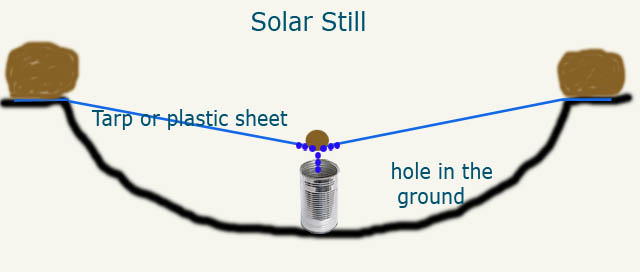Pocket Survival Guide
Your Resources Are Limited
Only By What Your Mind Can Conceive
|
Printing & Storing This Document
Prints 4 Pages (2 if front & back). Adjust Page Settings as needed.
Fold to 4 sections & store in a clear plastic zipper bag for each Kit/Pack
|
Eleven (11) Cs Camping / Emergency Kit
The "basics" of a camping/survival/emergency bag should include the 'Eleven (11) Cs' (listed below in the order of importance). They have multiple uses by themselves and, when used in combination with other "Cs", with basic survival skills, common sense and a level head, solutions can be created for nearly any situation. Obviously, some of these items would not normally begin with the letter "C" but are listed in this manner for the benefit of memorizing the list.
- Cutting Tool (QUALITY multi-tool, knife, hatchet, machete, saw, etc. - for repairs, cutting, first aid, defense or making defense tools, hunting)
- Combustion Device (matches, lighter, flint striker - for signaling, warmth, sterilizing, cooking)
- Covering (tarp, tent, plastic sheeting, ground cloth, mylar emergency/space blanket, etc. - for shelter, make-shift tent, ground cover, rain catcher)
- Canteen (container, water bottle, etc. - to carry and sterilize water and cook)
- Cordage (rope, paracord, strong nylon string, fishing line, dental floss, etc. - suturing wounds, tying and hanging things, snares to catch food)
- Candle (candles, glow sticks, solar or crank-flashlight, headlamp, etc. - for light and signaling)
- Compass (map, GPS - for navigation)
- Conduit Tape (duct, electrical, etc. - for repairs and bandaging)
- Catgut Needle (for sewing materials and suturing wounds)
- Cloth Fabric (chances you are already going to be wearing something that can be used for head covering, water filtering, bandaging, etc.)
- Communicator (whistle or loud noise-maker to call for help & save your voice/strength).
|
This Document
Contents of this document have been gleaned from sources believed to be reliable but should not be considered authoritative. You are solely responsible for your own actions on how you use this information and encouraged to do your own research on the topic(s) included. Periodically check back for the latest version (date @ page bottom of PDF version). See Page Header for Printing & Distribution recommendations. Contact P4T for corrections or suggestions. The web version contains working links (in red): www.5six7.com/survival/P4T/P4T-Pocket_Survival_Guide.htm
Very basic information is included here. Invest in, and carry, a full-fledged First Aid and Wilderness Survival Handbook like the SAS Survival Guide for its comprehensive content & compact size. The US Army Ranger Handbook & Survival Manual are available on the P4T web site. BEFORE VENTURING OUT, review the online version of this document, click and review all links (in red). Research further & practice for a thorough education. In a real-life situation, read all sections; those that may not appear to apply, may contain helpful information. Make personal notes for future reference.
Five (5) Components of Survival
1 - Supplies you have (11-Cs at the very least)
2 - Skills you have (learn/practice Fire-Building, First Aid & Survival techniques)
3 - Your physical abilities (break bad habits, eat well & stay physically fit)
4 - Luck
5 - Your will to live (do things to build morale & keep spirits high)
STOP: Stop - Think - Observe - Plan if an emergency does occur.
Stop & calmly analyze the situation. Think of what you need to do to survive. Observe surroundings & look for familiar landmarks. Plan out the next best course of action. The Lemon System & S-U-R-V-I-V-A-L sections can assist.
|
Rules of Three (Priorities) for Survival
[Article 2]
AIR - 3 minutes without fresh air can cause unconsciousness or death,
SHELTER - 3 hours in extreme weather can kill -- Build Shelter, start a fire (heat, cook, purify, boost morale) & make bedding to rest the body.
WATER - 3 days without water, dehydration sets in & organs shut down. Find, Collect or Make Fresh Water. Drink 1 gallon per day.
FOOD - 3 weeks without food, physical troubles set in -- Hunt, Fish or Gather Food
HOPE - 3 months without hope reduces the will to go on. Do things to build morale.
S-U-R-V-I-V-A-L
S = Size up the situation - What's going on? Identify your threats & strengths
U = Use all senses - Consider all aspects of the situation - no quick decisions
R = Remember where you are - Focus on what's around & direction to go
V = Vanquish fear and panic - clear your head and stay calm
I = Improvise - think of unique ways to use what is available
V = Value living - you need the will to survive
A = Assess uses for what you are wearing, carrying and what's around you
L = Live by your wits - remember (or learn) basic survival skills
|
Lemon System
Used to score how safe it is to continue. "Lemons" are bad circumstances like injury, illness, exhaustion, bad weather, damaged equipment, etc. At 3 lemons, stop and re-evaluate the decision to continue onward, fix the conditions, if possible, or discontinue (get out) if necessary.
1-10-1 Rule of Hypothermia
Avoid getting wet or sweating. Both can contribute to hypothermia.
1 minute - (if fallen into cold water) an immediate shock of cold will pass. During that time concentrate to avoid panic (calm down) and get breathing under control.
10 minutes - loss of effective use of fingers, arms and legs for any meaningful movement. Concentrate on self rescue and call out for help.
1 hour - unconsciousness will set in. Delay it by self rescue activities and calling for help.
NOTE: Feed a hypothermic person high-sugar foods/drinks and get them moving, warm & dry. Do not wrap them in a "space" blanket. Open it near a fire to reflect heat to them.
|
Morale - Keep Spirits High
Crucial in any survival situation. Build a fire, take a bath/shower, dry out, put on clean, dry clothes, have fun, play a game or instrument for a psychological boost. Get good sleep. Rejoice in small victories. Shrug off failures.
Injuries, Illness & First Aid
Mistakes can be costly. Injury/illness makes a bad situation worse. Don't take chances or cut corners on safety or sanitation. Having a First Aid Manual may assist with potential injuries & illnesses.
1. Don't use any body parts, except hands, to break wood
2. Re-think before eating or drinking anything (read Food section)
3. Keep wounds clean, dry & covered to avoid infection or contamination
4. Keep skin, especially feet, dry to avoid fungus, leading to severe injury
5. No first aid kit? Improvise with what you wear, carry, find or plant life
6. Pine sap: disinfect & cover wounds, stops bleeding & chew for sore throat
7. Plain sugar poured into a wound keeps it clean and aids healing
8. [Activated] Charcoal is an effective water & airborne contaminates filter. Scraped from burnt [hard] wood or purchased, crush & sandwich a thick layer between 2 cloth pieces to breathe thorough or strain water. Helps heal wounds. Mixing & drinking in clean water, treats diarrhea & internal poisoning.
|
Clothing, Hygiene & Sanitation
Clothing: Strive to keep clothes dry & clean to stay sanitized and warm. Dirt may prevent them from breathing & insulating. Headgear prevents the primary source of heat loss. Gloves help prevent injury during manual tasks.
Hygiene & Sanitation are important to reduce chances of illness & disease by keeping your body & mouth clean and handling food & water.
Defense
Carry tool(s) that are immediately available to stave off animals or human predators at a safe distance. Unless you packed alternatives , consider: WALKING STICK weapon from a living tree, about one inch thick in diameter, straight as possible and 3-5 feet long. Convert to a SPEAR by securely lashing a knife or long pointed, sharp rock or sharpen the point of the wood and place the pointed end into a bed of hot coals for about 1/2 hour. The wood will not burn but harden to give the stick an extra punch. A simple ROCK imparts lots of striking energy into a target. Pick the smoothest rock possible to avoid injuring your hand with sharp edges. Avoid brittle rocks or those with cracks. A CLUB is made with a shorter, heavier piece of wood or by securely lashing rock and stick together. Practice with, and test, all tools thoroughly for stability and balance before actual use. On the street use pepper spray, knife, cane, umbrella or anything in your hand to swing or throw. Take self-defense lessons. , consider: WALKING STICK weapon from a living tree, about one inch thick in diameter, straight as possible and 3-5 feet long. Convert to a SPEAR by securely lashing a knife or long pointed, sharp rock or sharpen the point of the wood and place the pointed end into a bed of hot coals for about 1/2 hour. The wood will not burn but harden to give the stick an extra punch. A simple ROCK imparts lots of striking energy into a target. Pick the smoothest rock possible to avoid injuring your hand with sharp edges. Avoid brittle rocks or those with cracks. A CLUB is made with a shorter, heavier piece of wood or by securely lashing rock and stick together. Practice with, and test, all tools thoroughly for stability and balance before actual use. On the street use pepper spray, knife, cane, umbrella or anything in your hand to swing or throw. Take self-defense lessons.
|
Find or build Shelter
Weather continues to be man's #1 survival adversary. If you're not dealing with it, you should be preparing for it. The first of 3 Laws of Survival, it is necessary to stay dry, warm and provide some level of protection from critters. If you do not have a tent , use what is available in your gear or the environment. , use what is available in your gear or the environment.
Step 1: Clear the ground down to the dirt, larger than the size of your intended shelter, to discourage critters from sneaking in
Step 2: Build the Shelter Frame
Step 3: Build a dry bed frame or padded area to stay off the bear ground which drains body heat
Step 4: Create a roof with a tarp , survival blanket or leafy branches , survival blanket or leafy branches
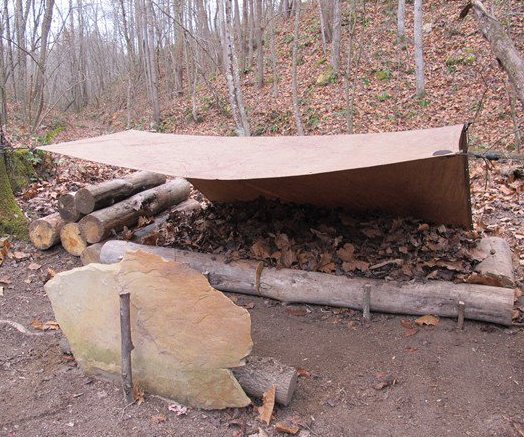
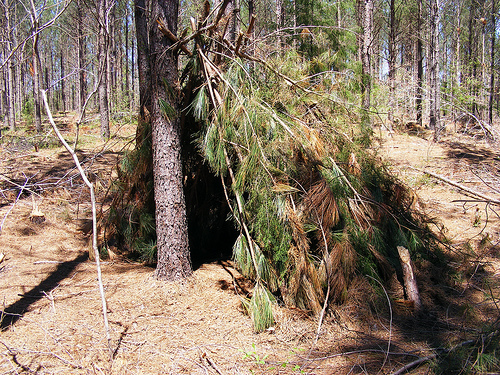
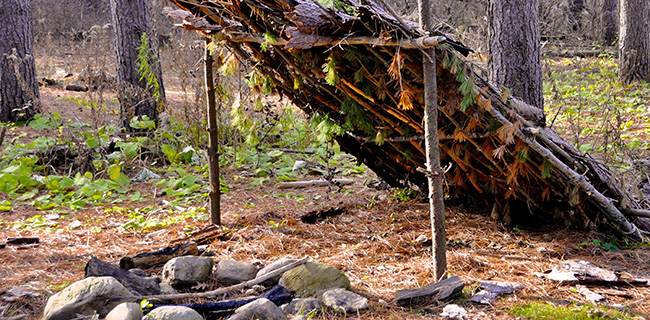
Build a Fire
Fire provides, heat, light, comfort and protection. Choose a location relative to your shelter and wind direction.
1. You need 3 items: Tinder (Dry/Flammable Material), Kindling (Grass/Bark/Twigs), and Fuel (Wood/Logs/Trees)
2. Take your Tinder and place in small area where you want to ignite fire
3. Take a cotton ball, sanitizing wipe, gun powder, or anything that will ignite on top of the tinder
4. Spark: You can use anything from a battery using wires, flint striker, matches, knife scrapping against surface which causes spark, Convex
lens (Magnifying glass, camera, binoculars), friction by rubbing 2 sticks together (hand drill, bow drill, fire plow)
5. As small fire starts to grow using tinder, add the kindling to build an adequate flame that will burn the fuel
6. Leaving some space between the pieces of wood, but not so much that they won't catch fire, will reduce smoke and increase flames.
7. Building a fire in a hole in the ground (Dakota Fire Pit) is useful for windy conditions, reduces detection (if stealth is desired) and can be closer to heat your shelter. It's also easy to put the fire out, filling the hole with dirt, when ready.
8. Char Cloth can be made as a ready-made, low-ignition, easily-transportable fire starter. Put a piece of cotton or wool cloth in an enclosed container and put over a fire for about 20 minutes (or when it has turned black). Once done, strike a spark to it for a quick ember that helps start a fire.
Build a Torch
Light provides comfort, protection and mobile signaling. Without a lantern or flashlight, you may want to build a torch from trees, plants or other available materials.
The best tree to use is fresh Pine but others with flammable sap (like Birch) will work as well to allow for slow burning. Cut or break a branch, as close to the tree trunk as possible, 3-4 inches in diameter then cut or break to the length to serve your purpose of carrying or sticking in the ground to be more permanent. Remove the bark about 8-10 inches on each end. At the tree-trunk end (which should be getting damp with sap), split it twice (to form an X) to make 4 sections and split down 6-8 inches without splitting it completely. Spread the sections apart and stuff green twigs into the split to hold it open to fill the center with wood chips or other burnable materials. Make cut marks on the outside of the torch end to help the torch burn more efficiently. Ignite the material inside the torch with your fire. For the first 2-3 minutes, keep the torch sheltered from the wind. You may have to hold the torch on its side or upside down to ensure that the initial flames heat the sap enough to create a sustained burning. Other torch methods to consider are cloth, tape, paper, vines and other materials wrapped around a stick or building a mini-fire inside a container for mobile light.
|
Food
Avoid eating critters raw. Cook or boil for several minutes or noticeably done. Smoke extra food, for later eating, by drying it close to, not in, the fire.
1. Insects are the best food source - Yeah, it's gross. But insects are always available and full of protein. Anything under 1 inch is game. Roast them to make more palatable. As a general rule, DON'T eat insects that are brightly-colored, hairy or have a potent smell (except stinkbugs). If in doubt about its edibility, cut off a tiny, cooked piece of it, swallow it, and wait a few hours. If you don't develop any symptoms, eat a larger piece and wait again. If nothing happens, it's probably fine.
2. Edible Plants are another option but much caution is need to make sure they are not poisonous. As a general rule, DON'T eat plants that have shiny leaves, milky or colored sap, any sort of spines, thorns or fine hairs, seeds inside pods, beans and bulbs, bitter or soapy taste, stems that have an almond scent, three-leaved growth patterns, white or yellow berries, umbrella-shaped flowers, grain heads with spurs that are pink, purple or black.
3. Hunting with Snares and deadfalls will be your best passive methods. Animal tracking will help identify trails where to set traps. Hunting can be a huge waste of time and energy resulting in dehydration with no food. If you are in dire straits, you must conserve energy and water. Reconsider plants and insects.
4. Fishing is a great option - but use a fishing weir; a trap placed in shallow water that lets fish swim in and prevents them from swimming out. It's easier than actively fishing and allows time to do more important things. Just come back and spear the trapped fish; like shooting fish in a barrel.

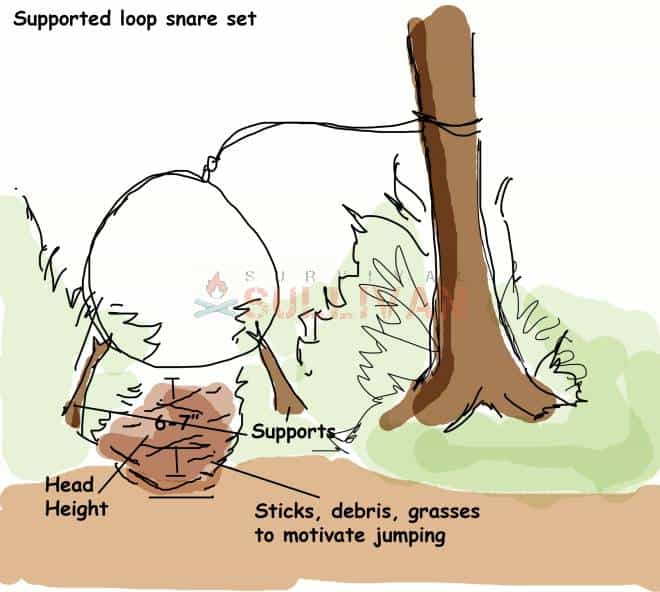

|
Signal for help
Some attention-getters are man-made geometric patterns such as straight lines, circles, triangles, or X's displayed in open, uninhabited areas. The universal signs of 3 markers or an "X" indicate trouble. Be ready, at a moments notice, to use the signal.
1. Use Noise-makers (whistle, banging rocks or sticks together). Avoid shouting to conserve energy & prevent injury to your throat. DO NOT use audible signals if you do not want to alert unwelcome rescuers (bad guys).
2. Build a signal fire to create dark smoke (using rubber or plastic)
3. In a clearing, setup contrasting materials (like branches on snow) as signal markings and direction of travel (arrow)
4. A shiny object (mirror ) can create a flash of sun toward a craft or people ) can create a flash of sun toward a craft or people
5. Use a flare gun or Sea (water) Dye Markers or Sea (water) Dye Markers
6. Use a firearm to shoot 3 shots (universal sign of distress) in the air
7. Spread clothing on the ground or in the top of a tree
8. Shine a flash light at a plane, boat or people
|
Your Gear
Take time to go through your available supplies (minimum 11-Cs). A First Aid Kit and Whistle are good additions. The P4T Camping Check List may help with selecting additional supplies.
• Look at each item, one after the other.
• Handle each item slowly and carefully.
• Rehearse in your mind why each item is significant, and what role it will fill in your current situation.
• Recall how past experience, information, and training has prepared you for each item's use.
• Secure Gear. Place each item securely in your pack, in proper order for use. Keep everything tied down or zipped closed.
• ALWAYS keep your pack on your person or within direct arm's reach.
• Never wander away from your pack to, possibly, forget where you left it.
• Never place your pack on a slope, hill, or ledge to, possibly, fall or roll away.
• Never leave items laying randomly on the ground, making them hard to find.
|
Find your way out / Navigation
Generally, stay where you are if you're lost, especially at night, if you are injured or near exhaustion. Stop, look and listen for familiar signs of civilization. Calmly and methodically develop a plan to go in that direction.
1. Without a compass, map or GPS device, remember the basic directional marker, the Sun; rising in the East and setting in the West. First, you must have an idea of what direction to take to reach civilization or other desired destination.
2. Getting to higher ground may help get your bearings and determine the best route to take
3. Travel in a straight line. Use landmarks to follow a straight line between two points ahead and line them up, and do the same thing looking back.
4. When possible, make noticeable marks along your path to help stay on your heading and help others find you
5. Following a drainage or stream downhill or downstream (except in Africa) may lead toward larger bodies of water and civilization.
|
Emergency Preparations & Planning
BEFORE a disaster happens, Document a Plan & Gather Supplies (11-Cs, Water=1 Gal. per person per day, etc.). Visit P4T to start your plan.
1. Soap: Stay Clean. Stay Healthy
2. Security: Have a safe room to ride out civil unrest. Secure doors & windows, install strong locks, make paths difficult for bad guys, have an alert system. Acquire or make tools and weapons.
3. Mobility: Learn about your exact location, neighborhood, town. Find stores for food/supplies. Get maps for routes/directions. Move quickly but don't run.
4. Fight or Flight: Decide how you will react before it's necessary. Is it safe to stay or is fleeing better? Are Resources nearly gone, is Environment safe, is Destination safer, are Overwhelming forces advancing, are you Unprepared for the situation, is Threat increasing
5. Communicate & stay informed. AM/FM/Weather Radio, whistle or hand signals.
6. Group survival is better than alone: Stay together, be a team-player, encourage, help, assign everyone responsibilities to fight boredom & worry.
|
Miscellaneous Tips & Information
1. Continuing to travel in severe weather conditions can cause injury or death. Seek shelter until conditions improve.
2. For better traction on ice, put socks on the outside of boots/shoes.
3. Deep snow walking: Build makeshift snowshoes to widen your footprint
4. To control a steep hill descent, angle your path (don't go straight down) & dig in & drag a walking stick behind you or sit and scoot
5. Bark on a downed tree causes rot - Remove bark to help preserve the log
|
6. Most wild animals avoid humans - Make noise to alert them during travel
7. Deter predatory animal attack - Make the back of your head look like a face
8. Consider how Litter can be used to help your situation
9. Disabled electronics: touch battery +/- terminals together to short & start a fire. Burn plastic to create dark smoke for signaling
10. Toilet Paper Alternatives: Non-poisonous plant leaves, smooth rocks, moss, grass, snow, water, corn/coconut husks, corn cob, pine cones/needles
11. Protect eyes from blowing sand, dust, wind, desert sun or snow blindness. Make goggles from tree bark, wood or your supplies (duct tape, etc.)
|
Survive in Cold Weather / Snow
Considered to be the most difficult to survive. Hypothermia = the major threat
1. Dirty clothes may prevent them from breathing & insulating. Keep them clean to stay sanitized & warm.
2. Limit strenuous activities to avoid exhaustion & sweating.
3. Wear clothing loose to breathe. Layer for better insulation.
4. Stay dry. Wear water-resistant clothes. Avoid snow and melting ice.
5. Most body heat is lost through the head. Keep it covered to stay warmer.
6. Avoid frostbite by covering your ears and fingers. Place hands under arm pits or somewhere warm.
7. Shelter: Out of the way of avalanche chutes. On the edge of a clearing. Dig a pit in the ground to avoid freezing winds. If you can't dig, build a framework first, then cover with debris. Allow shelter to breathe.
8. Stay warm. Keep hydrated. Snack on food to keep energy levels and body temperature high.
|
Survive At Sea
1. Minimize risk and conserve energy is top priority
2. Use life raft/jacket or latch together any floating debris to stay afloat.
3. Weigh Options: Only paddle for shore/land if you have an idea of where you're going. Stay put if you feel sure that someone will be searching for you
4. Protection: Scan wrecks for tarps, jackets, wool, waterproof, windproof clothing, etc. Protect yourself from wetness, wind, sun, and temperature. Dip clothes in water under hot sun to keep cool. Shade eyes or make goggles. Grease can be used as a sun-screen but it's best to stay out of the sun.
5. Stay Hydrated: Collect rainwater. Make a Solar Still to make drinking water from seawater. Drink as little as possible but stay hydrated. Conserve energy. Avoid drinking seawater; 32 ounces is risky but not life threatening if no fresh water is available. Avoid sweating. Conserve energy.
6. Watch for birds; they are a good sign that land is near. Generally speaking wind blows towards land during the day, and out to sea at night.
|
Survive in The Desert
1. Don't move unless you know exactly where you are, where you want to go, or have a map. Chances of rescue are better if you stay in one place.
2. Major threats are Exposure (Sun during day. Cold at night) and Dehydration. Wear loose layers to protect against direct sunlight on head, face and body. Wear a hat and goggles/glasses/scarf to avoid dust and debris harming eyes.
3. Ration water. Determine how much to drink by urine color. Light colored = fine. Dark color = drink. Purify any water before drinking it.
4. Stay hungry. Eating makes you thirsty which affects your water rationing. Nibble and snack on food.
5. Find/Build Shelter: Day temperatures can fry you; night temperatures can freeze. Find a safe place and build shelter to avoid the elements. Store food/water/materials inside the shelter.
6. Watch for spiders, snakes, insects and other animals that can harm you. Keep food sealed to not attract animals.
|
Survive in the Tropics
1. Everything thrives in a jungle (germs, disease, parasites, animals). This also means there is plenty to drink, eat, and provide shelter.
2. Weather is unpredictable with sudden rains, winds and storms. Never venture too far from a safe place or your shelter for protection.
3. Water can be hard to find. Use all senses; listen for waterfall and follow animals to water. In a muddy river bank, dig a hole 3 feet from the water's edge. Clear water should filter into the hole. Palm trees, roots, and vines also provide drinkable water.
4. Animals are a good source of protein. Plants are also sources of food but some might not be safe to eat. Unless you have knowledge of what to eat, try
bamboo, fruits and palms.
5. Watch for quicksand. It won't kill you; the human body is far denser. Worst case is being sucked down just above the waist and won't be able to get out, leading to thirst, starvation and death. Walk with a big stick that can help you exit. Avoid kicking or fighting it, but float.
Make small circles with your feet to move the sand under you. Eventually, you will be able to float/walk out.
|
Trees to Know -- Birch (drink, container, fire starter, adhesive), Basswood (food, cordage, fire drills, carving), Pine (patching, adhesive, antiseptic, wound covering, stop bleeding, fire tinder, food, Vitamin C, treat sore throat, insulation, bedding, shelter roof, waterproofing, lamp, cordage), Oak (bread flour, anti-bacterial, antiseptic, anti-diarrhea, squirrel trap bait, leather tanning, ax handle, digging stick, shelter framework, tinder bundle), Maple (energy drink, food, cooking utensils, hunting bow) and Willow (pain releiver, cordage, baskets, fire drills)
Knots to Know -- Knowing how to tie the correct knot for the situation keeps things secure and in control.
1. Bowline - for hanging food in a tree to keep it away from predators, in emergency rescues because the knot makes a loop to get a leg or arm through, for securing animals, such as horses, cattle, and goats because it doesn’t slip or tighten very much, so it's gentle on the animal's neck.
2. Clove Hitch - to lash anything together
3. Figure-Eight - for climbing, where safety is paramount and most widely used tie-in knot by mountain climbers
4. Sheet Bend - used to tie different ropes together despite varying rope thickness and material
5. Tautline Hitch - most useful for tents and lashing things down so that they don’t move
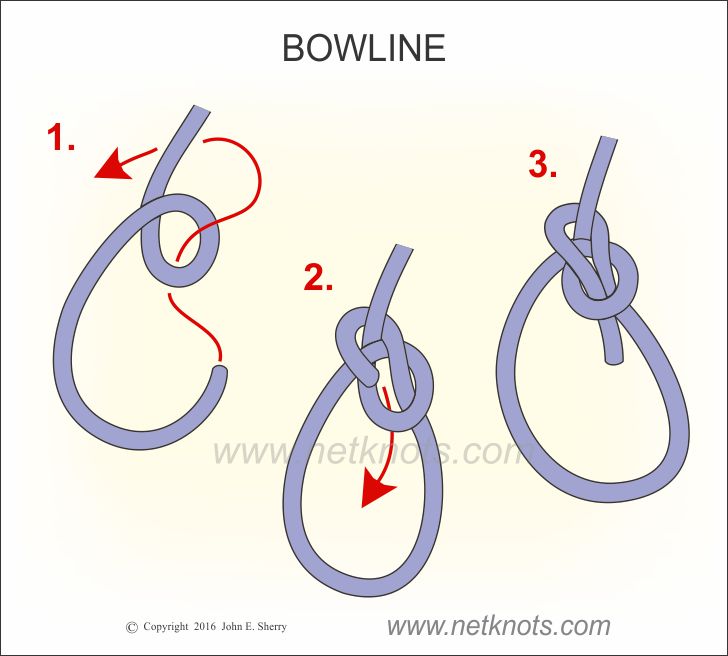

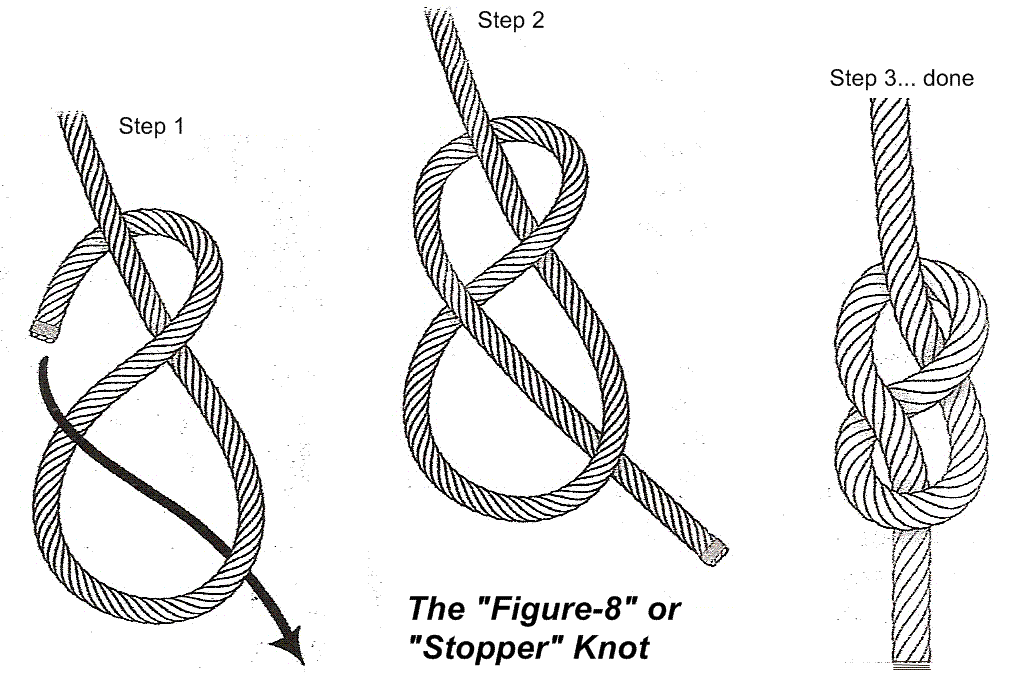

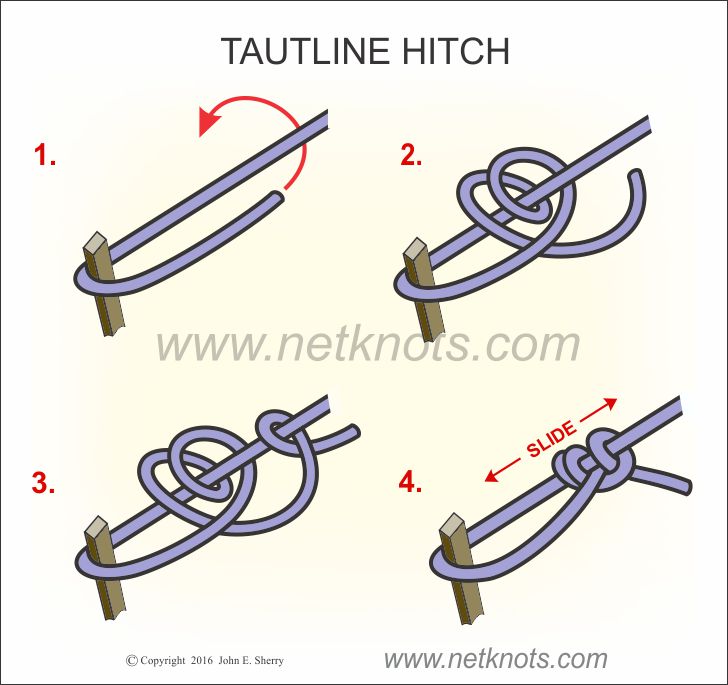 Reference: NetKnots.com
Reference: NetKnots.com
|



